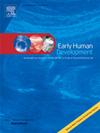极度早产儿童6岁时的一般运动和神经发育结果。
IF 2
3区 医学
Q2 OBSTETRICS & GYNECOLOGY
引用次数: 0
摘要
背景:极早产儿(EPT)面临着各种各样的神经发育挑战。那些最容易出现不良后果的患者应及早发现。目的:评估EPT婴儿在烦躁年龄时的一般运动(GMs),并研究烦躁运动(FMs)和运动优化评分-修订(MOS-R)是否与6岁时的神经发育结果相关。研究设计:纵向队列研究。受试者:38例EPT患儿(妊娠< 28周,女孩11例)。结果测量:使用Prechtl一般运动评估和3- 5个月婴儿运动最佳性评分(修订版)从矫正年龄3个月的录像中评估GMs。6年时评估神经学(Touwen)、认知学(WPPSI-III)和神经心理学(NEPSY-II,视觉空间和注意力)结果。结果:9例(24%)患儿有异常(异常/散发性/缺失)FMs,除1例外其余均有异常运动特征。中位MOS-R为21。异常FMs婴儿的全量表智商≤85 (FSIQ, OR 7.7, p = 0.03)和听觉注意≤-1SD (OR 12.8, p = 0.04)的比值比(OR)显著高于异常FMs婴儿。MOS-R得分与FSIQ (Spearman r = 0.39, p = 0.02)、绩效IQ (r = 0.47, p = 0.004)、视觉空间加工(几何拼图,r = 0.53, p = 0.006)和视觉注意(r = 0.29, p = 0.01)呈正相关。与异常FMs或MOS-R相关的总体预后或神经预后没有统计学意义。结论:与正常FMs和/或较高MOS-R相比,异常FMs和较低的MOS-R与更差的神经发育结果相关。本文章由计算机程序翻译,如有差异,请以英文原文为准。
General movements and neurodevelopmental outcome at 6 years in extremely preterm born children
Background
Infants born extremely preterm (EPT) face a variety of neurodevelopmental challenges. Those most at risk of adverse outcomes should be detected early.
Aims
To assess General Movements (GMs) at fidgety age in EPT infants and to investigate whether fidgety movements (FMs) and Motor Optimality Scores – Revised (MOS-R) are associated with neurodevelopmental outcome at six years.
Study design
Longitudinal cohort study.
Subjects
Thirty-eight EPT children (< 28 weeks of gestation, 11 girls).
Outcome measures
GMs were assessed from video recordings at three months corrected age using the Prechtl General Movements Assessment and The Motor Optimality Score for 3- to 5-Month-Old Infants – Revised. Neurological (Touwen), cognitive (WPPSI-III) and neuropsychological (NEPSY-II, visuospatial and attention) outcomes were evaluated at six years.
Results
Nine (24 %) of the infants had aberrant (abnormal/sporadic/absent) FMs and all but one had abnormal movement character. Median MOS-R was 21. Infants with aberrant FMs had significantly higher odds ratio (OR) for full-scale intelligence quotient ≤ 85 (FSIQ, OR 7.7, p = 0.03) and auditory attention ≤ −1SD (OR 12.8, p = 0.04). MOS-R scores correlated positively with FSIQ (Spearman r = 0.39, p = 0.02), performance IQ (r = 0.47, p = 0.004), visuospatial processing (Geometric Puzzles, r = 0.53, p = 0.006) and visual attention (r = 0.29, p = 0.01). Overall outcome or neurological outcome did not reach statistical significance in associations with aberrant FMs or MOS-R.
Conclusion
Aberrant FMs and lower MOS-R are associated with worse neurodevelopmental outcomes when compared to normal FMs and/or higher MOS-R.
求助全文
通过发布文献求助,成功后即可免费获取论文全文。
去求助
来源期刊

Early human development
医学-妇产科学
CiteScore
4.40
自引率
4.00%
发文量
100
审稿时长
46 days
期刊介绍:
Established as an authoritative, highly cited voice on early human development, Early Human Development provides a unique opportunity for researchers and clinicians to bridge the communication gap between disciplines. Creating a forum for the productive exchange of ideas concerning early human growth and development, the journal publishes original research and clinical papers with particular emphasis on the continuum between fetal life and the perinatal period; aspects of postnatal growth influenced by early events; and the safeguarding of the quality of human survival.
The first comprehensive and interdisciplinary journal in this area of growing importance, Early Human Development offers pertinent contributions to the following subject areas:
Fetology; perinatology; pediatrics; growth and development; obstetrics; reproduction and fertility; epidemiology; behavioural sciences; nutrition and metabolism; teratology; neurology; brain biology; developmental psychology and screening.
 求助内容:
求助内容: 应助结果提醒方式:
应助结果提醒方式:


